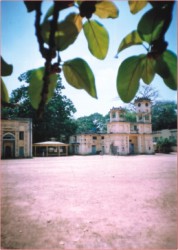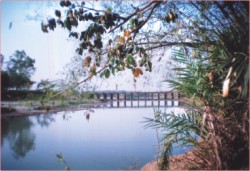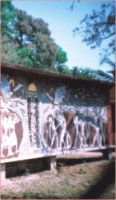Feature
A mystical journey
Wrishi Thakur Raphael
 To state that people from all around the world come to Santiniketan and Sriniketan on pilgrimage would not be an exaggeration, as the visitors not only wander around the Santiniketan premises, but also they experience an extraordinary journey to its spiritual realms while doing so. The various spots meriting a visit in Santiniketan speak of an antiquity, which not only prevails over a period of 100 years but has also served as the cornerstone of Bengali literature and culture. To state that people from all around the world come to Santiniketan and Sriniketan on pilgrimage would not be an exaggeration, as the visitors not only wander around the Santiniketan premises, but also they experience an extraordinary journey to its spiritual realms while doing so. The various spots meriting a visit in Santiniketan speak of an antiquity, which not only prevails over a period of 100 years but has also served as the cornerstone of Bengali literature and culture.
The Visva Bharati University, Santiniketan, founded by Gurudev Rabindranath Tagore, has been acknowledged as one of the world's echelons for fine arts and literature, maintaining uncompromising and unparalleled standards of excellence. The legendary figure of Bengali literature, Rabindranath Tagore, not only ambled down Santiniketan's lush green outfields, but the holy place also bears witness to the creation of many a masterpiece of literature. Many of the world's literary geniuses and music maestro's had their first lesson from this university. Some of Santiniketan's spots of grandiose beauty and historical significance are listed below.
· Chatimtala: Maharshi Devendranath Tagore, the poet's father, discovered “the comfort of his life, the joy of his mind and the peace of his soul” while meditating beneath a Chatim tree. This inspired him to buy 20 bighas of land from the Sinha's of Raipur in 1863. Here he eventually found his ashram. The original trees withered out and a new pair has been planted in their place.
 · Bakulbithi: To the south of Chatimtala is Bakulbithi, where one finds a large number of Bakul trees. At the foot of every tree is an enclosed gravel area of radius 3 to 4 meters, on which is built a small brick and mortar dais serving as the teacher's seat. These open-air classrooms have been praised for their uniqueness and ingenuity. · Bakulbithi: To the south of Chatimtala is Bakulbithi, where one finds a large number of Bakul trees. At the foot of every tree is an enclosed gravel area of radius 3 to 4 meters, on which is built a small brick and mortar dais serving as the teacher's seat. These open-air classrooms have been praised for their uniqueness and ingenuity.
· The Santiniketan House: The poet's father, after buying the land from the Sinhas, built the Santiniketan House, which closely resembles their ancestral home of Jorasanko in Kolkata. Right in front of the house stands the stone statuette of one of the most gifted sculptors of his time Ramkinkar Baij (a student of the university) known by many as “the inextinguishable light”. Some interpret the silhouette as a mother upholding her child before the Creator and praying for the child's welfare.
· The Prayer Hall: The heart of Santiniketan's existence owes greatly to three enclosures:1) Chatimtala,2) Santiniketan House and 3) the prayer hall which was inaugurated by Dwijendranath Tagore, the poet's eldest brother, in 1892. Since then a nondenominational prayer is held every Wednesday morning.
· The Mango Grove: What looks from afar as just another garden, in the midst of the Mango Grove lies a brick and mortar platform, where the annual convocation is held.
 It was here that an array of the most distinguished gentlemen of that time offered their felicitations to the poet on his winning the Nobel Prize on the 13th of November 1913. On Mahatma Gandhi's second visit here in 1940, he was given a reception by the poet himself in this Grove. It was here that an array of the most distinguished gentlemen of that time offered their felicitations to the poet on his winning the Nobel Prize on the 13th of November 1913. On Mahatma Gandhi's second visit here in 1940, he was given a reception by the poet himself in this Grove.
· Singha Sadana: The building has been erected with financial support of the Sinhas of Raipur and it was here where the poet Rabindranath's convocation was held when Oxford University decided to confer the D.Litt. Degree on the poet.
 · Sangeet Bhavana: It is a double-storied building with a stage for performances by students of the fine arts department. A branch of All India Radio is adjoined to Sangeet Bhavana and frequently arranges live telecast of cultural activities. · Sangeet Bhavana: It is a double-storied building with a stage for performances by students of the fine arts department. A branch of All India Radio is adjoined to Sangeet Bhavana and frequently arranges live telecast of cultural activities.
· Kala Bhavana: This department was born in 1919, a result of the accumulated efforts of artists like Nandalal Bose, Suren Kar, etc. All along its indoor and outdoor galleries are some of the most phenomenal statues curved out by Ramkinkar Baij example The Santal Family, “The Dandi March” etc.
· The Rabindra Museum: The Rabindra Museum is the most imposing and spectacular of all tourist attractions in Santiniketan. The first building is known as Vichitra, which houses the Rabindra Bhavana, the archives and the department of Tagore studies. Many of the poet's personal effects and several photographs of historical events related to his life have been preserved here. Followed by Vichitra is an assembly of living quarters of astounding architectural beauty. They have been named by the poet as Udayana, Konarka, Shyamoli, Punascha and Udichi respectively. These houses, with their exotically gardened lawns served as unending sources of inspiration, peace of mind and a degree of solitude that was so paramount to Tagore's creative endeavors. Most of the buildings were designed by eminent architect L. K. Elmhirst.
 Education at visva bharati at a glance Education at visva bharati at a glance
1. Patha Bhavana: From class 1 to 10
2. Uttar Siksha Sadana: Class 11 to 12
3. Sangeet Bhavana: B. Music, M. Music and Diploma in Music
4. Kala Bhavana: B. Fine Arts, M. Fine Arts, Diploma in Fine Arts and Certificate course
5. Siksha Bhavana: B. Sc. (Hons.), M. Sc. and PhD. (Science Stream)
6. Vinay Bhavana: B. Ed. and M. Ed.
7. P.S.B. (Agri College): B. Sc. And M. Sc. In Agriculture
8. Silpa Sadana: Furniture, Textile and Pottery Technology
9. Social Work: B. Social Work and M. Social Work
10. Siksha Charcha: Primary Teacher's Training Centre
11. Palli Charcha Kendra: B.A. And M.A. In Anthropology
As the world slowly falls into abysmal depths of perversion, sadism and anarchy, Santiniketan proudly exalts and upholds eternal beauty and perpetual bliss of the human soul. Even a brief encounter with Santiniketan and Visva Bharati may pacify even the most tempestuous of spirits; invigorating him to follow the paths of self-discovery and contemplation. The aura of Tagore's immortal spirit besieges Santiniketan. In a world of its own the divine serenity of this holy ground caresses the wretched soul and sooths the embittered mind.
| 